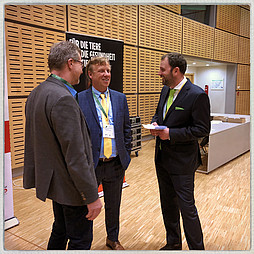Review of XXIII. Tagung
With the XXIII. Tagung über Pferdekrankheiten, another successful CPD event now lies behind us. As in previous years, a large professional audience was present (636 participants) who followed the presentations with great interest and actively took part in the discussion. During the conference breaks, the exhibitors at the trade exhibition found their stands to be very popular with the veterinarians.
The first conference day, where the partly international presentations were simultaneously translated into German or English respectively, featured a diverse selection of speakers from Europe and the US. During the first block of presentations, Prof. Gunther van Loon illustrated the diagnosis and clinical relevance of cardiac arrhythmias and Prof. Gayle Hallowell from Nottingham discussed the management of large colon impactions and displacements in the field, while Assistant Professor Liara Gonzalez from North Carolina presented insights regarding the difficulties of predicting intestinal viability intraoperatively. After the coffee break, during which the stands of the trade exhibition were eagerly frequented by the veterinarians, a range of orthopaedic topics were addressed. Prof. Alicia Bertone (Ohio) presented surgical techniques in the standing patient; Fabio TorreDVM (Bagnarola) addressed the preventive value of arthroscopic removal of OCD fragments and Dr. David Lichtenberg from Hochmoor presented a technique for arthroscopically assisted intralesional treatment of cysts in the medial femoral condyle where he placed a screw through the cavity of the SCL with promising results. Furthermore, the use of stem cells in treatment of joint disease, which is seen more and more critically by many experts, was discussed (Prof. Alicia Bertone, Prof. Wiltrud Richter).
In his second presentation, Dr. Torre reported his personal observations. During the last 20 years, along the principle of “less is more”, he refrained from applying antibiotics perioperatively for standard surgical procedures and found that the incidence of infection remained constant but there were fewer cases of typhlocolitis. Prof. Dr. Christian Willy talked about the use of antiseptic flushing solutions for wound treatment in human patients which could probably also be applied in equine medicine. The last block of presentations provided new insights in fluid treatment of gastro‐intestinal disease (Prof. Gayle Hallowell) where she also drew attention towards the possibilities of fluid administration per rectum. Liara Gonzalez vividly illustrated the influence of altered intestinal permeability on the postoperative course after intestinal surgery and Caroline Gerdes concluded the first conference day with her presentation on diagnosis and treatment of sacroiliac joint disease and dismissed the participants into the evening, which many of the veterinarians rounded off at Dr. Ende’s Equitana stand.
Saturday started with presentations by Dr. Ralf Pellmann, Dr. Maren Hellige and Dr. Hubertus Lutz assessing changes in the area of the neck and poll and their clinical relevance. Pellmann impressively highlighted the importance of thorough clinical and radiological diagnostics in order to locate problems in the area of C5, C6 and C7. He also suspected possible hereditary causes for this set of symptoms. Subsequently, Dr. Franz Schlederer presented a positioning system for equine anaesthesia developed by him which opens up an interesting perspective, especially under the aspect of a „safe recovery phase“. His innovative approach to facilitate the process of anaesthetic induction and positioning of a horse and thus improve treatment of the patient is highly interesting.
The second half of the morning was dedicated to the increasing influence of investors in veterinary hospital groups. During the panel discussion, a lively and sometimes heated debate concerning the risks of this development arose. On the one hand, opportunities for employed veterinarians in hospital groups with more regular hours and improved income were pointed out; on the other hand, concerns about the current undermining of the veterinary fee schedule and abolition of OOH services, influence of investors on universities and possible higher costs due to excessive diagnostics were also voiced. The cooperation between universities and hospital groups was critically observed by veterinarians in private practice and the question of possible conflicts of interest arising for individual university lecturers was raised.
The afternoon was headed by the commemoration of the founder of the Tagung über Pferdekrankheiten, Prof. Bernhard Huskamp, who passed away in 2018. Dr. Hans Lauk, long‐term veterinary companion of Bernhard Huskamp, outlined his lifetime achievement in an entertaining presentation and honoured the manifold merits of Prof. Huskamp regarding equine surgery and also equine medicine as well as the training of numerous equine surgeons in Hochmoor. During a joined presentation, lawyer Dr. Burkhard Oexmann and veterinarian Dr. Caroline Wirth addressed the forensic aspects of cardiac and pulmonary disorders. Afterwards, Dr. Eberhard Schüle pointed out the sources from which the standards for veterinary due diligence are derived. The last block of presentations once more dealt with clinical topics; Karin Hendricks from Utrecht illustrated the possibilities and prospects of success of artificial insemination in mares; Caroline Gerdes addressed special aspects in diagnostics of proximal suspensory ligament desmopathy and with Dr. Guido Stadtbäumer’s informative talk on the diagnosis and treatment of mandibular joint disease, the Tagung über Pferdekrankheiten came to an end.
During the coffee and lunch breaks, in addition to the varied culinary offers the participants could also explore plenty of innovations at the trade exhibition such as for example very practicable, extendable carts for laptops or ultrasound units from Podoblock, positioning mats from Medser, safety belts for horses by Dr. Fritz as well as various systems for digital radiography and much more.
We would like to thank all of our speakers who made this event possible with their readiness to invest time and effort to process and share their insights as well as our generous sponsors, exhibitors and all supporters who have contributed to a successful conference.

![[Translate to English:] Unser Team [Translate to English:] Unser Team](/kv/_processed_/e/b/csm_IMG_0701_89eb660de3.jpg)








